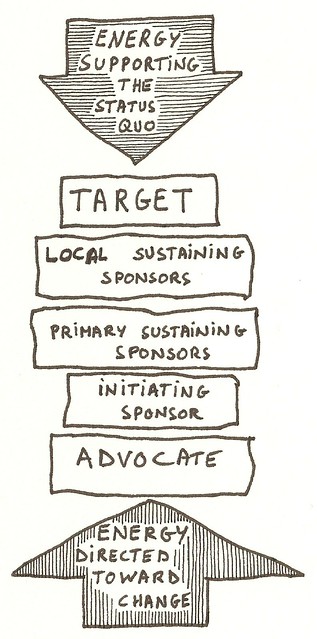In this article I describe four processes that take place when we go local to spend time with the change targets and the local sustaining sponsors. Being aware of these processes is important – and that is an understatement.
On every occasion that I get to talk about our profession you will hear me talk about the importance of ‘going local’, ‘being there’ and ‘spending time’. I have been in this evangelizing mode for a few years now, and I am likely to continue along that path.
As much as going local involves travel, logistics, time away from work that will inevitably pile up while you are out-of-office, it also involves … a reason for you to go local and meet the people who will eventually make the change happen. In 99% of the cases this reason is NOT a kind invitation for you to come over and see what’s cooking.
Nope. The ‘reason’ for you to go local is almost always a form of resistance. Regular readers of this blog know that I approach resistance as a good thing, i.e. a sign that someone has the courage to reach out to us and tell us what needs to change. When that happens I always go to through the roof when I hear project managers and change practitioners claim that we just need articulate the objectives of the project harder and be more convincing on the benefits of the project.
People are not stupid. When they speak up we should acknowledge their courage to do so in the first place. It’s called listening and it creates a connection. So beware, because when you decide to use the tools attached on both sides of your head you may end up like I always do.
For starters, you may dsicover that the arguments of local people make sense and that they are worth exploring. That is when you are likely to bump into the so-called ‘change targets’ and the ‘local sustaining sponsors’ (terminology borrowed from Daryl Conner). They are the persons you will be meeting ‘over there’. Have a look at the below drawing to see how they match up in the energy field.

Now a little something on the processes that take place when you go local. As obvious and straight-forward as they may seem, it is important for us to be aware of them. By simply being aware of these processes we will be able to resist the temptation to behave against these processes to unfold. In short: being aware of what is supposed to happen when you ‘trust the local soup’ will prevent you from messing up by being right all the time.
- The process of making sense. When you go local and you are interested in how people look at your project, how they define the benefits and downsides from their perspective; a dialogue takes place. As long as you are capable of explaining instead of justifying and listening instead of judging you will be fine. You are now establishing a relationship. The exchange of points-of-view is what we call sense-making. Learning takes place on both ends of the relationship.
- The process of saving face. This is something you really need to experience because you never think about it when you are in the cocoon of the project. Most of the times the local sustaining sponsors travel to the central office in order to participate in workshops and meetings of the project. They are representing their local team / tribe at those moments. But workshops and meetings are consensus driven processes that are reinforced by our toolkits of decision-making and meeting techniques. What we don’t realize at that time is the fact that each local sustaining sponsor will need to sell this consensus whenever they head back to their local site. You will find that when you go local, that you will need to help the local sustaining sponsor in selling the future state and consensus to the local targets. ‘Saving face’ may be a pejorative way of putting it, but it is an awkward thing to see how they behave differently in front of their local colleagues. Your job is to help them grow guts – and NOT to rescue them by taking the stage in front of their colleagues (in fact – when you do that, you are killing them on stage).
- The process of crafting a social fabric. Kurt Lewin used to say that in order to understand a system, you should try to change it. The same goes for projects; in order for people to get to know each other, they need to be in the same project. You will find that people who may be with the same organization for more than a decade meet each other for the first time on your project. I am always surprised when this happens and this makes me aware of the uncertainties and suspicions that are natural during a first meeting. Too often we take it for granted that all the people in the room know each other. They don’t – and certainly not in the face of the change you are presenting to them. So our job is to allow and even to facilitate a new social fabric to be established in te wake of the project. I call it social architecture.
- The process of deepening the shared pool of meaning. In the book Crucial Conversations Tools for Talking When Stakes Are High
(affiliate link), the authors state that mastering a crucial conversation requires being open and honest in expressing opinions and feelings, even when the ideas in question are controversial or unpopular. Each person enters a conversation with different thoughts and feelings and they make up a personal ‘pool of meaning’. Our job is to make it safe for everyone to bring their inputs out into the open – into a ‘shared pool’. As the ‘shared pool’ is added to, it grows. As this happens, we all benefit in terms of more accurate and relevant information, better choices, and higher involvement on whatever decisions are made.
Throughout the years I have experienced these processes as difficult to monitor because it is nearly impossible to keep a distance. As an organizational change practitioner you need to be fully present and able to be in service of the relationship / social fabric / social architecture. This requires a different skill-set as being the expert who is always right. Try it. You’ll get a kick out of it too.



Pingback: Buy-in is a Double-loop Process | Reply-MC()